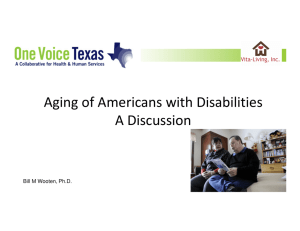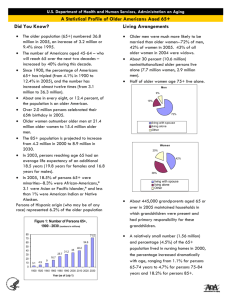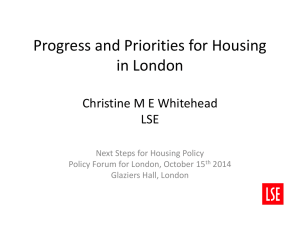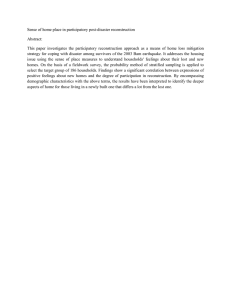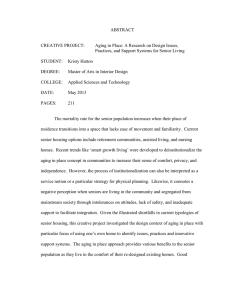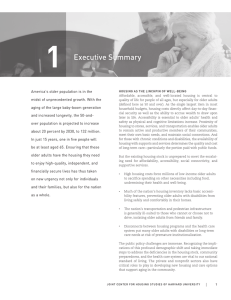1 Executive Summary America’s older population is in the
advertisement
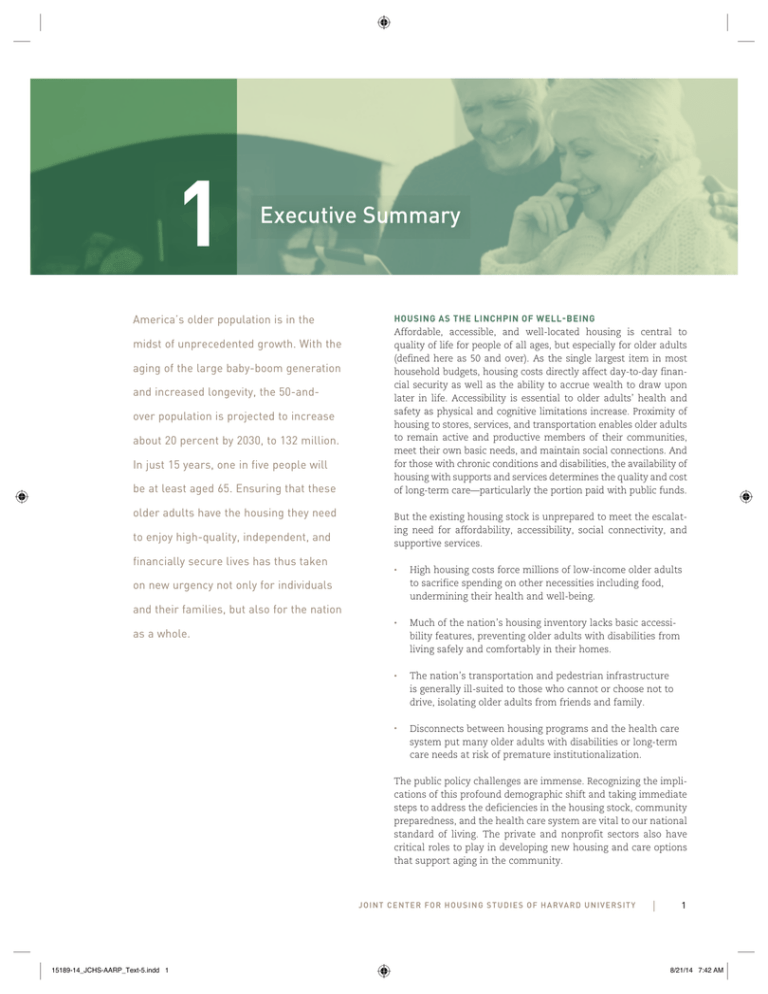
1 1 Executive Summary Executive Summary America’s older population is in the midst of unprecedented growth. With the aging of the large baby-boom generation and increased longevity, the 50-andover population is projected to increase about 20 percent by 2030, to 132 million. In just 15 years, one in five people will be at least aged 65. Ensuring that these older adults have the housing they need to enjoy high-quality, independent, and financially secure lives has thus taken HOUSING AS THE LINCHPIN OF WELL-BEING Affordable, accessible, and well-located housing is central to quality of life for people of all ages, but especially for older adults (defined here as 50 and over). As the single largest item in most household budgets, housing costs directly affect day-to-day financial security as well as the ability to accrue wealth to draw upon later in life. Accessibility is essential to older adults’ health and safety as physical and cognitive limitations increase. Proximity of housing to stores, services, and transportation enables older adults to remain active and productive members of their communities, meet their own basic needs, and maintain social connections. And for those with chronic conditions and disabilities, the availability of housing with supports and services determines the quality and cost of long-term care—particularly the portion paid with public funds. But the existing housing stock is unprepared to meet the escalating need for affordability, accessibility, social connectivity, and supportive services. • High housing costs force millions of low-income older adults to sacrifice spending on other necessities including food, undermining their health and well-being. • Much of the nation’s housing inventory lacks basic accessibility features, preventing older adults with disabilities from living safely and comfortably in their homes. • The nation’s transportation and pedestrian infrastructure is generally ill-suited to those who cannot or choose not to drive, isolating older adults from friends and family. • Disconnects between housing programs and the health care system put many older adults with disabilities or long-term care needs at risk of premature institutionalization. on new urgency not only for individuals and their families, but also for the nation as a whole. The public policy challenges are immense. Recognizing the implications of this profound demographic shift and taking immediate steps to address the deficiencies in the housing stock, community preparedness, and the health care system are vital to our national standard of living. The private and nonprofit sectors also have critical roles to play in developing new housing and care options that support aging in the community. J O I N T C E N T E R FO R H O U S I N G S T U D I E S O F H A R VA R D U N I V E R S I T Y 15189-14_JCHS-AARP_Text-5.indd 1 1 8/21/14 7:42 AM But the issues at hand are also intensely personal, affecting older adults’ ability to remain independent and enjoy a high quality of life. Ultimately, it is up to individuals and their loved ones to consider their housing preferences, assess the readiness of their homes and communities to support them as they age, and plan for needs they might not yet have. CHANGES IN THE OLDER POPULATION The older adult population has grown tremendously since the first of the baby boomers (born 1946–64) turned 50 in the mid1990s. Between 1990 and 2010, the number of people of at least that age jumped by 35 million, an increase of 55 percent (Figure 1). With the oldest baby boomers reaching retirement age after 2010, the population aged 65 and over is projected to soar to 73 million by 2030, an increase of 33 million in just two decades. By 2040, the aging baby boomers will also push up the population aged 80 and over to 28 million, more than three times the number in 2000. The older population will also become more diverse as the wave of young immigrants that arrived in the United States in recent decades reach age 50. With this growing diversity will come significant shifts in housing demand, reflecting the different housing situations and financial circumstances of minorities. For example, older Asians and Hispanics are more likely to live in multigenerational households than whites or blacks. Their rising numbers will therefore affect not only the demand for institutional care, but also the housing, financial, and personal situations of their family members. And as a group, minorities have lower rates of homeownership, lower median incomes, and fewer assets, all of which affect their housing options. FIGURE 1 The Older Population Is on Track to Increase Dramatically 70 60 50 40 30 20 10 0 65–79 At the same time, the numbers of low-income older adults will climb. Assuming the share remains what it is today, millions more people aged 65 and over will have low incomes in the years ahead. The incidence of housing cost burdens also rises with age as incomes fall. As it is, however, a third of households aged 50–64 already pay excessive shares of their incomes for housing. Indeed, of special concern are the younger baby boomers who are now in their 50s and less financially secure than previous generations in the aftermath of the Great Recession. With their lower incomes, wealth, and homeownership rates, members of this large age group may be unable to cover the costs of appropriate housing and/or long-term care in their retirement years. The younger baby boomers are also less likely to be parents, implying that fewer family members will be available to care for them as they age. On top of all these challenges, aging brings greater risk of isolation. In addition to the many older adults with disabilities who have limited access to their communities, millions of older households live in outlying areas, no longer drive, and lack transportation services. Moreover, older adults—particularly women—are increasingly likely to live alone, with single-person households making up 40 percent of all households in their 70s and fully 60 percent of households in their 80s. These householders often have disabilities as well as limited financial resources. HOUSING PREFERENCES The vast majority of the 50-and-over population currently lives independently—that is, within the community rather than in institutional care facilities. Many are still in the workforce, some embarking on second or third careers. Younger members of this age group may be part of the so-called “sandwich generation” that juggles work, care for children, and care for parents. Population by Age Group (Millions) 50–64 In addition, the numbers of older adults with physical and cognitive limitations will increase sharply over the coming decades. With age, people are increasingly likely to face disabilities that pose challenges to living independently (Figure 2). The US Department of Health and Human Services (HHS) estimates that nearly 70 percent of people who reach the age of 65 will ultimately need some form of long-term care. This care can be costly, adding to the pressures on financially stretched older adults. 80 and Over But even among individuals aged 80 and over, more than three-quarters live in their own homes. Indeed, “aging in place” is the preference of most people. In its recent survey of 1,600 people aged 45 and older, AARP found that 73 percent strongly agreed that they would like to stay in their current residences as long as possible, while 67 percent strongly agreed that they would like to remain in their communities as long as possible (Keenan 2010a). ● 1990 ● 2000 ● 2010 ● 2020 ● 2030 ● 2040 Source: US Census Bureau, Decennial Censuses and 2012 National Population Projections (middle series). 2 Still, many households opt to move in their older years. Household changes such as retirement, children moving from the home or H O U S I N G A M E R I C A’ S O L D E R A D U LT S — M E E T I N G T H E N E E D S O F A N AG I N G P O P U L AT I O N Age Group 15189-14_JCHS-AARP_Text-5.indd 2 8/18/14 1:31 PM adult children returning to it, a disability, or death of a spouse give rise to new housing needs and preferences. In particular, finding more affordable housing may become a greater concern for those living on fixed incomes. But financial constraints also prevent people from adapting to their changing circumstances. Indeed, 24 percent of survey respondents expressed a preference to stay in their homes for as long as possible because they could not afford to move. CONVERGING TRENDS While staying healthier and living longer than ever before, most older adults and their families must ultimately confront many of the same challenges of aging. In particular, disability rates converge over time. For example, the share of 50–54 year olds with some type of disability ranges from 7 percent of those with at least $60,000 in annual income to 33 percent of those earning less than $30,000 (Figure 3). By age 85, however, more than two-thirds of individuals have some type of disability no matter what their race/ethnicity, income, or housing tenure. Income also drops with age for all groups. The typical income of households aged 80 and over ($25,000) is less than half that of households aged 50–64 ($60,300). This across-the-board drop in income reduces disparities by race/ethnicity and tenure. For example, the incomes of white households aged 50–64 are fully $31,000 higher than those of same-aged black households. By the time households reach their 80s, though, the white-black income disparity is just $5,100. THE CHALLENGES AHEAD It is unclear whether the baby boomers will follow the current trend of aging in place or whether new housing options will encourage many to move from the larger homes where they raised families. But for the millions in this age group who will stay in their current homes, ensuring their ability to do so affordably, comfortably, and safely presents several challenges. Housing Affordability As the single largest expenditure in most household budgets, housing costs directly affect financial security. Today, a third of adults aged 50 and over—including 37 percent of those aged 80 and over—pay more than 30 percent of income for housing that may or may not fit their needs. Among those aged 65 and over, about half of all renters and owners still paying off mortgages are similarly housing cost burdened. Moreover, 30 percent of renters and 23 percent of owners with mortgages are severely burdened (paying more than 50 percent of income on housing). Having to devote a substantial share of their incomes to housing, older cost-burdened households are forced to scrimp on other critical needs. For example, severely cost-burdened households aged 50 and over in the bottom expenditure quartile spend 43 percent less on food and 59 percent less on health care compared with otherwise similar households living in housing they can afford. Of particular note, severely cost-burdened households aged 50–64 save significantly less for retirement. Older homeowners are in a much more advantageous position when they retire. In addition to having lower housing costs, FIGURE 2 Aging Brings Increasing Risks of Disability, Isolation, and Financial Stress Share Facing Difficulty by Age Group (Percent) 45 40 35 30 25 20 15 10 5 0 Cognitive Self-Care Independent Living Mobility Live Alone Housing Cost Burden Type of Difficulty ● 50–64 ● 65–79 ● 80 and Over Notes: A cognitive disability is defined as serious difficulty remembering, concentrating, or making decisions; self-care disability as difficulty bathing or dressing; independent living disability as difficulty doing errands alone; and mobility disability as serious difficulty walking or climbing stairs. Housing cost burden is defined as paying more than 30 percent of income for housing costs. Source: JCHS tabulations of US Census Bureau, 2012 American Community Survey. J O I N T C E N T E R FO R H O U S I N G S T U D I E S O F H A R VA R D U N I V E R S I T Y 15189-14_JCHS-AARP_Text-5.indd 3 3 8/21/14 7:43 AM homeowners—and even those who still carry mortgages—typically have considerably more wealth than renters in terms of both home equity and non-housing assets. Resources can support the expense of changing needs later in life, including long-term care. The typical homeowner aged 65 and over has enough wealth to cover nursing home costs for 42 months and enough non-housing wealth to last 15 months. The median older renter, in contrast, cannot afford even one month in a nursing home. Indeed, only 18 percent of renters could pay for nursing home care for more than a year. But homeownership rates vary widely by race/ethnicity. Among adults aged 50 and over, 82 percent of whites own homes, compared with just 58 percent of blacks, 62 percent of Hispanics, and 70 percent of Asians. As the minority share of the population grows, this disparity implies that more and more older adults will be housing cost burdened and therefore have less wealth to tap to meet their needs as they age. In addition, given that households in their 50s today confront a number of financial pressures, including more mortgage and non-housing debt, cost burdens may become even more widespread over time. Housing Accessibility Millions of older adults who develop disabilities live in homes that lack accessibility features such as a no-step entry, single-floor living, extra-wide doorways and halls, accessible electrical controls and switches, and lever-style door and faucet handles. Indeed, the 2011 American Housing Survey reports that just 1 percent of US housing units have all five of these universal design features. Roughly two in five housing units in the country have either none or only one of these features. Because of regional differences in housing stocks, homeowners in certain areas may have to make major modifications to enable a household member with disabilities to remain at home. For example, many homes in the Northeast are built on multiple levels and fail to provide a bedroom and bathroom on the first floor, while nearly 84 percent of homes in the South provide single-floor living. Even so, the costs of extensive home renovations, such as adding a first-floor bath or a no-step entry, are generally lower than costs of extended stays in assisted living or nursing care facilities. Defining Aging in Place The Centers for Disease Control and Prevention (CDC) defines aging in place as “the ability to live in one’s own home and community safely, independently, and comfortably, regardless of age, income, or ability level.” If needed, those aging in place may receive care or assistance by paid or unpaid (often family) caregivers. The CDC’s focus on aging in place as an ability hints at the dynamic nature of this process. As the gerontology literature recognizes, older residents renegotiate how—and indeed if—they can continue to stay in their homes as their preferences and circumstances (health, finances, relationships, and family and social supports) shift over time (Andrews et al. 2007). Aging in place is best undertaken with preparation, including adaptations of physical space, modes of transportation, or other facets of life in 4 advance of physical or cognitive need. For some, it may involve moving to other homes that are more comfortable, safe, affordable, and/or convenient—whether within the current community or to locations with more resources or closer proximity to family. For others, aging in place may reflect a desire to maintain their current living arrangements or occur simply by default. While there is no universally accepted definition of aging in place, many researchers, advocates, and commentators point to the same list of elements needed to make remaining in one’s home both possible and desirable: • • affordable, secure, and physically accessible housing; affordable, safe, and reliable transportation alternatives for those unable or unwilling to drive; • • opportunities to engage in recreational, learning, cultural, volunteering, and/or social experiences; and options for in-home health care and/or assistance with activities of daily living (ADLs) if needed to preclude a move to congregate care. Individual adults, of course, have their own set of preferences for housing and community. For example, a 2014 AARP survey found that most respondents give high priority to increased police presence and school improvements, but their rankings of the importance of access to various services and amenities range widely. The report also points out that choices of housing and community are often made at younger ages and left unexamined until some life event forces a reevaluation of those preferences (Harrell et al. 2014b). H O U S I N G A M E R I C A’ S O L D E R A D U LT S — M E E T I N G T H E N E E D S O F A N AG I N G P O P U L AT I O N 15189-14_JCHS-AARP_Text-5.indd 4 8/18/14 1:31 PM FIGURE 3 Disabilities Affect Most People in Their 80s Regardless of Race/Ethnicity, Tenure, and Income Share of Population with Disabilities by Age Group (Percent) 80 80 80 70 70 70 60 60 60 50 50 50 40 40 40 30 30 30 20 20 20 10 10 10 0 0 0 —— Race/Ethnicity White Black —— Hispanic Asian/Other —— Housing Tenure Owner Renter —— — Household Income Less than $30,000 $30,000–59,999 $60,000 or More Notes: Disabilities include hearing, vision, cognitive, mobility, self-care, and independent living difficulties. Whites, blacks, and Asian/others are non-Hispanic. Hispanics may be of any race. Data exclude population living in group quarters. Source: JCHS tabulations of US Census Bureau, 2012 American Community Survey. Publically subsidized units are more likely to have accessibility features than unassisted low-cost units. Yet rental assistance reaches only a fraction of the older low-income population—even those with disabilities. The lack of accessible, affordable housing can result in premature stays in nursing homes or the inability to return home after a hospitalization. Social Connection Additional hurdles to aging in community are insufficient supports and services and/or a lack of transit options and safe pedestrian walkways. The majority of older adults live in low-density suburban and rural areas where it is difficult to shop, access services, or visit family and friends without using a car. As a 2010 AARP report revealed, about one in five respondents aged 50 and over occasionally or regularly missed activities they would like to do because they had limited their driving or given it up entirely (Keenan 2010b). City dwellers have greater access to transit but are no less at risk of isolation if they are unable to leave their homes alone because they lack transportation to where they need to go, do not have friends and family nearby, or have safety concerns. While transit may be an option for some, older adults use the services less often than other age groups—suggesting that public transportation may not meet their needs for convenience, safety, affordability, and reliability. Long-Term Care For individuals with disabilities or chronic conditions, the ability to age in place depends on having access to long-term care in their homes or communities. While Medicaid and Medicare generally do not cover such costs, some state Medicaid Home and Community-Based Services (HCBS) waivers do. Some may even pay for the cost of home modifications to improve accessibility. But eligibility requirements for this support vary widely and need outruns availability. For those who are not Medicaideligible or do not qualify for waivers, the costs of in-home care can be substantial. At any given time, only about 2 percent of older adults reside in group care settings. Even so, assisted living facilities, nursing homes, and hospices provide critical support for those recovering from acute medical episodes or at the end of life. According to HHS, 37 percent of those aged 65 and over will receive care in an institutional facility at some point in their lives, with an average stay of one year. THE WAY FORWARD Given the widely varying circumstances of older adults, meeting their housing and housing-related needs requires a range of responses. At the individual level, older adults and their families must plan for the time when they have to confront the vulnerabilities of aging. Financial preparations, including building sav- J O I N T C E N T E R FO R H O U S I N G S T U D I E S O F H A R VA R D U N I V E R S I T Y 15189-14_JCHS-AARP_Text-5.indd 5 5 8/22/14 4:15 AM ings, managing debt, and obtaining long-term care insurance, are all important steps toward continued self-sufficiency. Thoughtful choices about where to live, the type of housing to occupy, or the type of home modifications to make—in advance of disabilities or chronic conditions—make it more possible to age in place without compromising safety or social connections. But many people in their 50s and 60s simply lack the resources to obtain appropriate housing and services as they age. Middleincome adults may discover that long-term care insurance and senior housing communities or other suitable alternatives are too expensive. Low-income households have even more limited options for good-quality, affordable, and appropriate housing. Those living in locations without social connections, family, or other supports nearby may find themselves isolated as they become more physically vulnerable. For these reasons, it is critical that the public and private sectors take steps to ensure that housing and health care systems support appropriate and costeffective options for low-income older adults, and that communities provide housing, transportation, and service options for their older populations regardless of income. In fact, a number of promising entrepreneurial approaches have already emerged in the realms of design, urban planning, health and wellness, social engagement, and finance. Numerous cities and states are advancing livability principles through housing, transportation, and walkability initiatives, as well as through ordinances to promote accessibility in private homes. Various nonprofit and public initiatives are demonstrating the benefits of linking housing with long-term care. The private sector is also developing new housing options, technologies, and services in recognition of the potential market for assisting older adults with aging in the community. A broader conversation, however, is essential to help spread these initiatives so that more older adults can benefit from them. First, a number of federal efforts need to be expanded. In particular, rental assistance makes a crucial difference in the quality of life for those who recieve it. At their current scale, however, programs reach only a fraction of older renters with low incomes and high housing costs. Additional funding for housing with supportive services is also essential, given the limited number of new units added 6 in recent years and the need for reinvestment in much of the housing that does exist. In addition, changes to Medicare and Medicaid would enable better coordination of affordable, accessible housing with long-term care. For their part, state and local governments can promote accessibility in both the home and built environments, as well as expansion of housing and transportation options. For example, they can require that all new residential construction include certain accessibility features, and offer tax incentives and low-cost loans to help owners modify their homes to accommodate household members with disabilities. Localities can also change their zoning to support construction of accessory dwelling units and mixeduse developments that add housing within walking distance of services or transit. Municipalities—particularly the growing number with large 50-and-over populations—need to ensure that a range of services are available to older adults, including social and volunteer opportunities; education programs centered on health, finance, and housing maintenance; adult day care and meals programs; and health and wellness services. Meanwhile, state Medicaid programs can reorient their funding to enable low-income households to age in the community rather than in institutional facilities, as many are doing through HCBS waivers. And with better coordination, state and local government programs for older adults would not only save on costs but also provide better outcomes. For the private sector, the growth of the older adult population provides vast opportunities to innovate in the areas of housing and supportive care. Indeed, substantial business opportunities exist in helping older adults modify their homes to suit evolving needs, delivering services at home, and developing new models of housing with services that promote independence and integrate residents with the larger community. While there are significant challenges ahead, the potential is there for older adults to have a higher quality of life than ever before, and for communities to be increasingly livable and vibrant as a result. But effective action will require concerted efforts at all levels of government as well as by the private and nonprofit sectors, and through the advocacy of older adults themselves. H O U S I N G A M E R I C A’ S O L D E R A D U LT S — M E E T I N G T H E N E E D S O F A N AG I N G P O P U L AT I O N 15189-14_JCHS-AARP_Text-5.indd 6 8/18/14 1:31 PM
